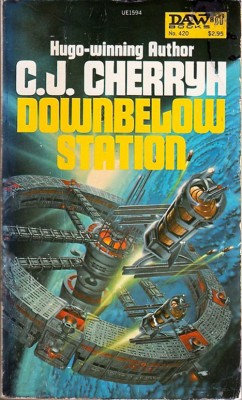 Planets are not the only setting for science fiction stories–space stations are common as well. From the Death Star (“that’s no moon…”) to Downbelow Station, the Venus Equilateral to ISPV 7 to the Battle School in Ender’s Game, space stations are a major staple of any space-centered science fiction.
Planets are not the only setting for science fiction stories–space stations are common as well. From the Death Star (“that’s no moon…”) to Downbelow Station, the Venus Equilateral to ISPV 7 to the Battle School in Ender’s Game, space stations are a major staple of any space-centered science fiction.
The reasons for this should be fairly obvious. Before we can go to the planets and the stars, we need to have a permanent presence outside of this massive gravity well we call Earth. The easiest and most logical place to expand first is to orbit, where supplies can be ferried up without too much difficulty and astronauts can escape in case of an emergency. Indeed, with the International Space Station, that’s exactly what we’re doing right now.
In science fiction, of course, space stations go much further than they do in real life. They’re often giant orbital cities, with thousands of people living and working there permanently. Often, they feature some sort of rotating toroidal structure in order to simulate gravity. If there are settlements on the planet below, the station often serves as a major hub for commerce, serving as a waypoint for interstellar merchants and wholesalers who ferry their wares up to orbit. And if the planet is still being colonized, then the space station often serves as an important umbilical to the outside universe.
They can also have strategic value in the event of a war. Battleships need to be serviced too, after all, and a station’s position in orbit can provide an excellent platform from which to bombard or lay siege to the planet. Alternately, outposts at more distant locations like the Lagrange points can serve as a staging ground for future attacks–a sort of astronomical “high ground,” if you will. If nothing else, abandoned stations may contain supply caches that can aid a fleeing starship, or provide shelter behind enemy lines, as was the case with the first Halo game.
Stations can come in all sorts of different flavors, from the puny to the magnificent. The most eye-popping station of all is probably the Ringworld from Larry Niven’s series of the same name. As the name would imply, the station is a giant ring–so huge, its circumference is the orbit of a habitable planet, with the sun at its center! Gravity is provided by rotation, and night and day by giant orbiting panels that block out the sun at regular intervals.
My favorite stations, though, are the more realistic ones–the ones that I can imagine myself living on someday. That was one of the things I enjoyed about Downbelow Station by C.J. Cherryh–her depiction of human expansion into space is eminently believable, and her stations are a natural extension of that. I also really enjoyed her focus on the social dynamics of living on a giant station, and what it would be like to live in such a society.
The Battle School from Ender’s Game is another huge favorite of mine. One of the advantages of building a structure in space is that gravity becomes malleable, so that some parts of the structure can simulate Earth-surface gravity while others leave people completely weightless. The Battle School uses that to its advantage, with the main training room a zero-g laser tag battle arena, where the students have to learn how to stop thinking in terms of the planar dimensions, where “up” and “down” have any meaning. It’s really quite fascinating.
It should come as no surprise that space stations pepper my own works. They’re especially common in the Star Wanderers series, where few worlds have been terraformed and orbital platforms make up the majority of human living space (at least in the Outworlds). In Sholpan and Bringing Stella Home, James, Ben, and Stella are all from a space station–a distinction that is especially useful for Stella, since her Hameji captors despise the “planetborn.” Genesis Earth takes that a step further, as spaceborn Michael and Terra have never been to the surface of a planet before until midway through the novel. Just as going into space is paradigm shifting for us, the experience of walking on a planet proves just as transformative for them.

I love the description of a space station that orbits a sun, how magnificant that must be.
Rinelle Grey
Yep, that’s Ringworld. There’s a mountain six miles high where an asteroid slammed into the backside of the ring and made a huge dent–apparently, they call the mountain the “Fist of God.”